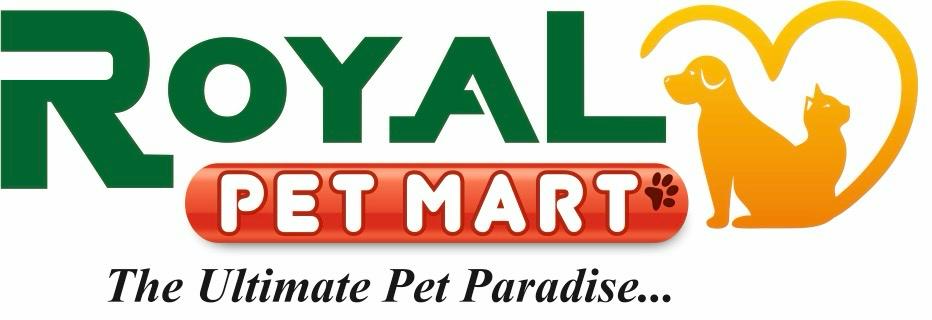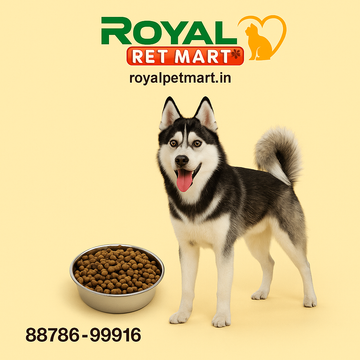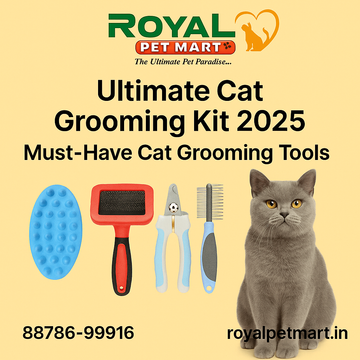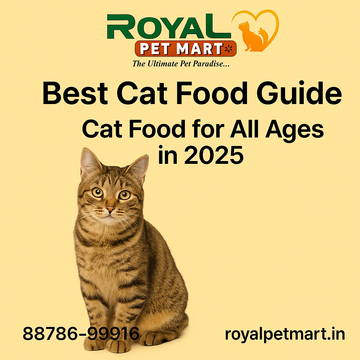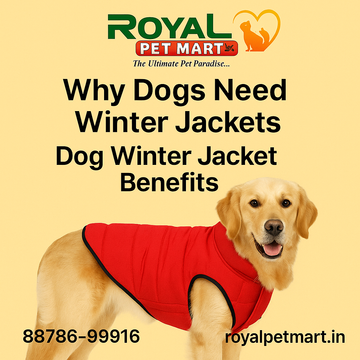Love in Every Bite: Nutritious and Healthy Foods Your Dog Can Have
by Royal Pet mart on Apr 23, 2025
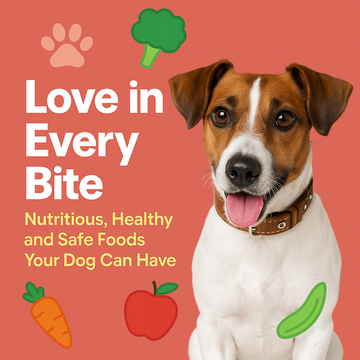
All pet owners can tell when their dog is happy by its wagging tail and sparkling eyes, but owners should know that dog nutrition is incredibly important to keep tails wagging. Feeding our canines is not only about putting food in the bowls, it is an introduction to their health , their energy-levels, and even their behaviours. A healthy diet can make a significant difference when it comes to a dog’s health, from a shiny coat to a healthy immune system. Finding good quality dog food for dogs at home can span anything! At Royal Pet Mart, we’re passionate about helping you feed your furry friend foods that are safe, nutritious, and tail-waggingly delicious. In this guide, we’ll explore what can dogs eat, share a dog safe food chart, and answer common questions like “is raw egg good for dogs?” Ready to show your pup some love through their diet? Let’s dig in!
What Makes a Food Safe and Nutritious for Dogs?
All dogs require a balanced combination of proteins, fats, carbohydrates, vitamins, and minerals. A dog diet should provide energy, maintain a healthy weight, and support health and wellness over time. Not all foods are equal – what’s good for humans to eat, isn’t necessarily safe for dogs. Good nutrition food for dogs will contain good quality proteins (like chicken or fish), digestible carbohydrates (like rice), and reasonable fats (like fish oil).
So what’s the difference between human food and dog-safe human food. Humans can eat, and enjoy, spicy, salty, and calorie-laden food, but dogs do not have the same systems. For example, dog-safe food contains low-sodium levels, no toxic ingredients, and is easy on their stomach. An apple slice is great food, chocolate is not. At Royal Pet Mart, we suggest you stay with anything that is safe food for dogs, which would be the same suggestions we have for humans: hydrogenated oil, fried foods, lean meats, raw veggies, etc. Not sure what to feed dogs? Keep reading for a breakdown of safe and nutritious options.
Human Foods Dogs Can Eat (People Food List)
Wondering what people food can dogs eat? Good news—your kitchen is full of foods dogs should eat that are both safe and beneficial. Here’s a rundown of dog-friendly human foods, with tips on portions and prep:
-
Fruits Good for Dogs:
-
Apples (seedless, chopped): Packed with fiber and vitamin C, a small slice is a sweet treat.
-
Blueberries: Antioxidant-rich and perfect for training rewards.
-
Bananas: High in potassium, but feed sparingly due to sugar content.
-
Watermelon (rind-free): Hydrating and refreshing, great for hot days.
-
What Vegetables Can Dogs Eat:
-
Carrots: Crunchy, low-calorie, and great for dental health.
-
Green beans: Filling and fiber-rich, ideal for weight management.
-
Pumpkin (cooked, plain): A superstar for digestion, especially for upset stomachs.
-
Broccoli (steamed, small amounts): Nutrient-dense but don’t overdo it due to gas.
-
Safe Table Foods:
-
Cooked chicken (boneless, unseasoned): A lean protein for muscle health.
-
Boiled rice: Gentle on the stomach and great for sensitive pups.
-
Plain yogurt (no sugar): Probiotics for gut health, but only in small doses.
Portion Control: Even what can dogs eat should be given in moderation. You should limit the treats, including human foods, to 10% of your dog's daily calories. As an example, a medium size dog could get a half of a carrot or a tablespoon of pumpkin. Be sure to chop foods into smaller bite-size pieces to avoid choking and always check Royal Pet Mart for ideas on fruits for dogs and veggies for dogs!
Homemade Meals: Preparing Food for Dogs at Home
Want to take control of your dog’s diet? Making food at home for dogs is a great way to know exactly what they are eating, and having fresh, healthy ingredients. Healthy meals for dogs can come from items you already keep in your kitchen, which will save you money! Here are the steps to making well-balanced home-prepared meals:
Proteins: Use lean sources of meat (chicken, turkey, fish). A small amount of raw egg (cooked, please) is also a nice protein addition- make sure to check with your vet for their opinion; is raw egg good for dogs? The answer depends on your dog.
Carbs: Conveniently filled with energy and easily digestible, boiled rice or sweet potatoes are great carbohydrate options.
Veggies: Carrots, green beans, and pumpkin are vegetables that can add fiber and vitamins.
Fats: Pouring a little fish oil or flaxseed oil on your dog’s meal contributes to coat/joint health.
Here’s an example of a good meal equation (for a 30-pound dog): 1 cup cooked chicken, ½ cup boiled white rice, ¼ cup steamed carrots, and 1 teaspoon of fish oil. Depending on your dog’s activity level/size will allow you to add/subtract food and still have a balanced meal. What should I feed my dog daily? Your dog's daily intake should be made up of 50% protein, 25% carbohydrates, 25% vegetables. Consult with your vet to help you make very good balanced meal.
Benefits: Preparing meals at home allows you to bypass preservatives, and customize recipes to your dog’s needs; for example, allergies or weight objectives. For more ideas on food for dogs at home, and veterinarian approved recipes to keep your pup healthy and happy, come visit Royal Pet Mart.
The Best Foods for Digestion and Energy
A happy gut means a happy dog. The best thing for digestion includes foods that are gentle, fiber-rich, and packed with nutrients. Here are top picks for foods dogs should eat to boost digestion and energy:
-
Pumpkin: High in fiber, it regulates bowel movements and soothes upset stomachs.
-
Oatmeal (cooked, plain): A gentle carb that’s easy on sensitive tummies.
-
Probiotic-rich foods: plain yogurt or kefir (small amounts) helps gut flora.
-
Chicken broth (low-sodium): hydrates and supports picky eaters
-
Ingredients for immunity: blueberries, spinach, salmon, etc.-anti-oxidants and omega-3s provide a lot of benefits, and we want to make it easier for dogs to fight off infection, allergies, etc. List 4 food items that change or provide nutrients: carrots, salmon, apples, and oats have been great for digestion and overall health.
-
Signs of digestive issues: Keep an eye out for vomiting, diarrhea or lethargy! If your dog always struggles after meals, just feed boiled rice and chicken until he is well again, then take him to the vet. Royal Pet Mart has a dog safe food chart, that is a helpful resource while looking for digestible food for dogs.
Foods to Avoid: What NOT to Feed Your Dog
Not all foods are safe, and some foods are dangerous. Here is a list of what can dogs eat - rather - what they can't:
-
Toxic Foods:
-
Chocolate: Contains theobromine, can cause heart problems.
-
Grapes and raisins: Linked to kidney failure.
-
Onions and garlic: Damage red blood cells, even in small amounts.
-
Avocado: Persin can upset stomachs.
-
Problematic Foods:
-
Dairy (in excess): Many dogs are lactose intolerant, leading to gas or diarrhea.
-
Fatty meats: Can cause pancreatitis or obesity.
-
Salty snacks: Harmful to kidneys and heart.
Common Myths: Some believe raw egg is a superfood, but uncooked eggs pose a salmonella risk and may interfere with biotin absorption. Always cook eggs unless your vet approves. Is boiled rice good for health? Yes, it’s a safe, bland option for upset stomachs, but it shouldn’t be the only food in your dog’s diet.
Royal Pet Mart reminds you to double-check ingredients before sharing table scraps. When in doubt, stick to food that’s good for dogs to keep your pup safe.
Puppy Diet vs. Adult Dog Diet
Puppies have unique needs, so what a puppy can eat differs from an adult dog’s diet. What should I feed my dog at this stage? Puppies require higher calories, protein, and calcium for growth and development. A dog diet for pups should include:
-
Puppy-specific foods: High-quality kibble or homemade meals with 25-30% protein.
-
Frequent meals: Feed 3-4 times daily until 6 months, then transition to 2 meals.
-
Safe treats: Small pieces of carrot or apple, avoiding heavy fats.
Transitioning to Adult Food: Around 12-18 months (depending on breed), switch to adult food for dogs at home or kibble. Gradually mix new food with old over 7-10 days to avoid stomach upset. Royal Pet Mart offers guidance on what a puppy can eat to ensure your little one grows strong and healthy.
Quick Reference: Dog Safe Food Chart
Here’s a handy dog safe food chart to keep in your kitchen, grouped by category with prep tips:
-
Fruits Good for Dogs:
-
Apples (no seeds, chopped)
-
Blueberries (whole, small handful)
-
Bananas (sliced, sparingly)
-
What Vegetables Can Dogs Eat:
-
Carrots (raw or steamed, chopped)
-
Green beans (cooked, plain)
-
Pumpkin (cooked, mashed)
-
Grains:
-
Boiled rice (plain, no seasoning)
-
Oatmeal (cooked, no sugar)
-
Proteins:
-
Chicken (cooked, boneless)
-
Salmon (cooked, deboned)
-
Eggs (fully cooked, occasional)
Prep Tips: Always remove seeds, pits, or bones. Cook meats and grains thoroughly, and avoid salt, spices, or oils. For more ideas, check Royal Pet Mart’s dog safe food chart at https://royalpetmart.in/.
Conclusion: Feed Your Dog with Love and Care
A healthy dog diet goes beyond food—it demonstrates to your pup you care. Dogs eat a variety of food dogs should eat including carrots, boiled rice, and lean proteins increase happiness, digestion, energy and wellness. When you decide to use food for dogs at home or high-quality kibble and good food balance and safety are priorities. Avoid toxic foods, portion control, and ALWAYS consult a veterinarian before making big pet dietary changes especially with puppies and dogs with health concerns.
At Royal Pet Mart, we want you to feel confident you are giving good dog nutrition knowledge. From what vegetables can dogs eat to what people food can dogs eat, our resources at royalpetmart have you covered. Start small—swap a processed treat for a slice of apple or a spoonful of pumpkin—and watch your dog thrive. Here’s to many more years of love in every bite!
